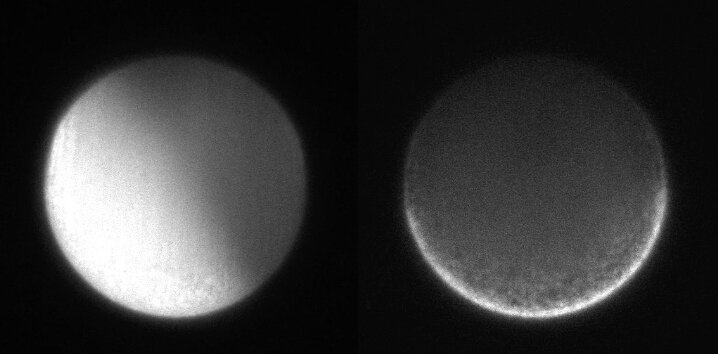Egg cells start out as round blobs. After fertilization, they begin transforming into people, dogs, fish, or other animals by orienting head to tail, back to belly, and left to right. Exactly what sets these body orientation directions has been guessed at but not seen. Now researchers at the Marine Biological Laboratory (MBL) have imaged the very beginning of this cellular rearrangement, and their findings help answer a fundamental question.
“The most interesting and mysterious part of developmental biology is the origin of the body axis in animals,” said researcher Tomomi Tani. An MBL scientist in the Eugene Bell Center at the time of the research, Tani is now with Japan’s National Institute of Advanced Industrial Science and Technology.
The work by Tani and Hirokazu Ishii, reported this week in Molecular Biology of the Cell, shows that both parents contribute to the body orientation of their offspring. For the animal species studied in the research (sea squirts), input from the mother sets the back-belly axis while that of the father does so for the head-tail axis.
“Both the maternal and the paternal cues are required to establish the body plan of the developing animal embryo,” stated Tani.
This research addresses fundamental questions in developmental biology and may also provide clues as to why things sometimes go wrong. Such knowledge could benefit fields as diverse as medicine and agriculture.
The prevalent theory of how the body axis is set has been that actin filaments inside the egg, which are involved in cell motion and contraction, power the rearrangement of cytoplasmic material in the egg after it has been fertilized. But seeing this happen has been a challenge because the onset of the process takes place rapidly and over very small distances within living cells.
To overcome these hurdles, Tani and Ishii used a fluorescence polarization microscope, a technology developed a few years ago at MBL by Tani, Shalin Mehta (now at Chan Zuckerberg Biohub) and MBL Senior Scientist Rudolf Oldenbourg, along with scientists at other institutions. This technology makes it possible to image events taking place at distances measured in nanometers, or thousands of times smaller than the diameter of a human hair. The methodology is also a familiar one to Tani and others.
“Using polarized light for looking at dynamics of molecular order is a tradition of MBL imaging,” Tani noted, one that began with pioneering live-cell studies by Shinya Inoué in the 1950s.
When polarized, light waves oscillate either partially or completely in only one direction: up/down, left/right, clockwise/counterclockwise, and so on. That’s why a filter will let polarized light through in one orientation, but block it when rotated.
Tani and Ishii attached fluorescent probe molecules, which glow when illuminated with the right light, to the actin in eggs of sea squirts (Ciona), a marine species often studied by researchers as a model for animal development. The probe-actin link was very rigid, Tani said, allowing the microscope to detect the orientation of the actin molecules by working with polarized light.
So, if the actin all pointed in one orientation, the researchers spotted it. If the actin was jumbled, they could see that too. When Tani and Ishii looked at unfertilized eggs, they saw a mostly random arrangement of actin. After fertilization, a calcium ion wave passed through the egg and the actin filaments lined up and contracted along the orientation that was at a right, or 90o, angle to the future back/belly axis. The cytoplasm then moved. This body plan formation process began just after fertilization.
The fertilized egg orientation research is being followed up with other investigations. One of the long-term goals of such imaging is to detect and understand the force in the developing embryo that shape its morphology, its form and structure.
“We hope that the molecular orders in the cytoskeleton tell us something like ‘field lines’ of mechanical forces that organize the morphology of multicellular organisms,” Tani said in discussing future efforts.
Microscope developed at MBL tracks individual molecules in living cells
More information:
Hirokazu Ishii et al, Dynamic organization of cortical actin filaments during the ooplasmic segregation of ascidian Ciona eggs, Molecular Biology of the Cell (2020). DOI: 10.1091/mbc.E20-01-0083
Provided by
Marine Biological Laboratory
Citation:
Imaging the first moments of a body plan emerging in the embryo (2021, February 4)
retrieved 4 February 2021
from https://phys.org/news/2021-02-imaging-moments-body-emerging-embryo.html
This document is subject to copyright. Apart from any fair dealing for the purpose of private study or research, no
part may be reproduced without the written permission. The content is provided for information purposes only.
